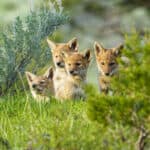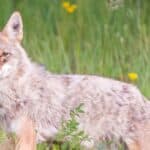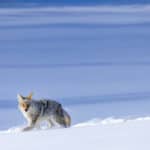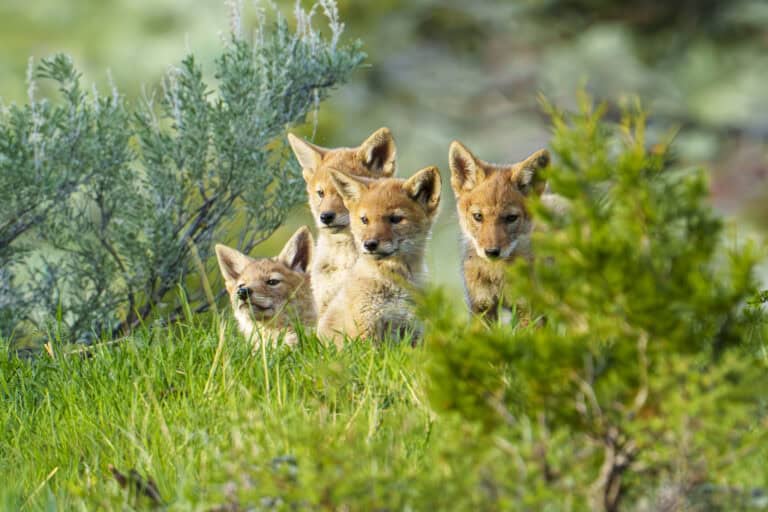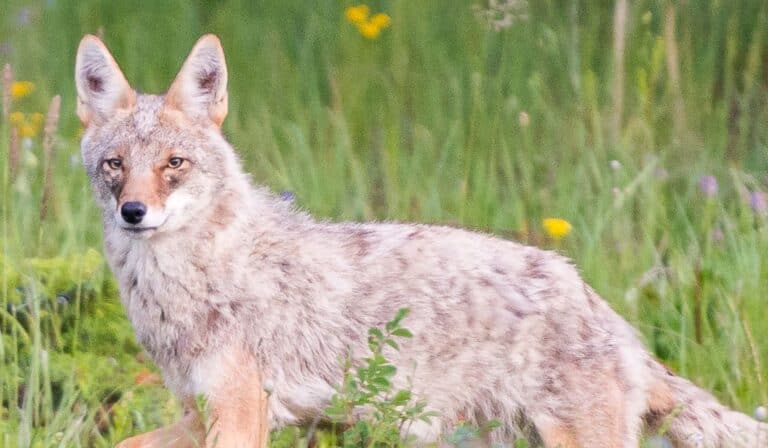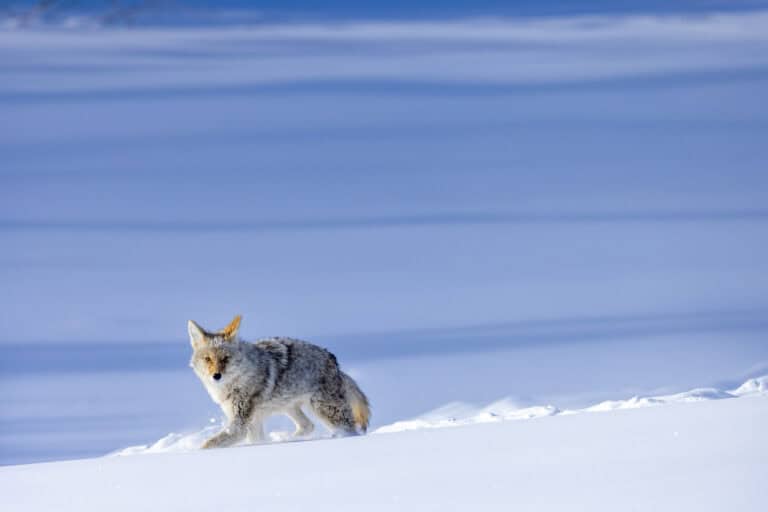Photo: Coyotes come equipped with a variety of well honed senses to tackle a variety of different environments. The amber colored eyes of the coyote are optimal for hunting in low light, such as dawn and dusk. Also, a huge set of ears and long snout ensure that little escapes the attention of this clever predator. (Trish Carney)
Constant expansion of the human race means development into wild life areas. We destroy natural exosystems and everything inside of them including animals, their small homes and habitats ideal for aging and hunting, all to progress ourselves. It’s no wonder that human encounters with large predators usually ends with the predator turning tail and fleeing the scene. Spend enough time in the field, and you may come to understand that animals are terrified of people.
Although, if there is one large carnivore that seems to be ready for anything, it’s the coyote. They are highly adaptable, cunning hunters and foragers, opportunistic, intelligent, with a keen sense of their surroundings – changing or not. Their overall prowess and bold attitude is not without its drawbacks. Coyotes have caught the attention of humans and are seen by many as demons. Their misunderstood behavior has people seeking them out to be obliterated off the radar. Despite hundreds of years of persecution, coyotes thrive. Much of the coyotes success is due to people who realize that ecocide of an entire species is not the right road to tread. Executive Director of Project Coyote, Camilla Fox interviews… and she has a howl and bite of her own.
Why was the coyote labeled as a demon in the first place?
There’s actually been a lot of literature on how predators have been demonized over the centuries by differentiation between entire species as well. So, for example, if you look at the way we portray bears compared to wolves there’s a pretty distinctive difference. Smokey the Bear and teddy bears, and other kinds of soft, cuddly bears are something that we have been brought up with since we were little. So there’s a lot of positive imagery for bears. And for the wild canids, there’s a lot of negative imagery and horror stories [like] Little Red Riding Hood.
Certainly, when you look at Native American lore and their projection of coyotes, it’s a mixture. Coyotes are seen as tricksters and they are seen as creators and ancestors. They have dual personalities, polarities, but it’s a recognition of their adaptability, they intelligence, their keen awareness. So I would not portray Native Americans as demonizing coyotes whatsoever. In fact, I think we have much to learn about the fact they saw all attributes and aspects of this native carnivore.
So, I can’t tell you where or when the demonization started, except to say that when European colonists stepped foot on this continent, they viewed the large, native carnivores as threats to livestock and species that should’ve been hunted for game – whether that was mountain lion, or wolf, or bear, or coyote. And like wolves and the mountain lions and other species, there was very little tolerance for coyotes. So, since European settlers stepped foor on this continent, we have waged a war against predators and I think that stems from an anti-predator viewpoint that goes back centuries in Europe. And, of course, they did a fairly good job at eradication of their large carnivores and pretty much repeated that when they colonized the states.
When it comes to ranchers, it seems that bad weather and disease cause far more losses for ranchers than predators do, yet they always seem to catch all the flack.
(Keli Hendricks, a rancher working with Project Coyote chimes in) Yeah, I feel like that’s the one thing that ranchers can control. You know, they might not be able to control the weather or birthing defects, but they think by killing predators, they can control losses. It’s a culture that they kind of grew up with. With their ancestors hating predators and that results in an exaggerated perceved threat. So that, in their minds, they think that predators present much more losses than they actually cause. In reality, predators take much less livestock than any other reason.
So since killing predators is much more graspable to ranchers, coyotes become portrayed as more of a scapegoat.
Yeah, I think that they can become a scapegoat and there are lots of non-lethal ways that ranchers can protect their livestock, but choose not to for many reasons, and they find that killing is much easier. A lot of times they do it out of revenge.
(Camilla Fox returns) Josh, I’d like to also say something about that. I think that when you look historically that our federal government has de-sensitized the killing of predators, first by hiring private hunters and trappers to systematically eradicate predators from the west. Then with the formalization of predator control under the Animal Damage Control Act in 1931, which, pretty much, was caused by the federal government’s involvement in predator control efforts; that subsidy and that welfare to ranchers has insured that a culture of anti-predator sentiments has persisted. And I think until our government shifts away from killion coyotes and other predators, through promoting more ecologically humane, sound, non-lethal approaches, that prejudice against predators is going to persist.
Project Coyote isn’t an organization just for coyote rehabilitation, but for promotion of co-existence between all wildlife and humans. So why choose the coyote as your poster animal?
We chose the coyote as our ambassador (or flagship animal) because they are the most persecuted, misunderstood, maligned native carnivore in North America. We estimate at least 500,000 coyotes killed every year in the U.S. alone. And that averages to just about one a minute. And we believe that if we can shift the way that we treat coyotes, we can shift the way we view and treat all predatores. If we can overcome that prejudice against the species that creates such conflict, they will then be the ambassadors for our path to co-existence with other predators.
What would North American ecosystems look like if coyotes were thrown out of the picture?
Well, this is interesting timing because Keli and I just returned from a gathering of our Science Advisory Board in Yellowstone, and we are asking these very questions in video interviews. We interviewed, among others, Dr. Michael Soule, who is known as the Father of Conservation Biology and serves on our Science Advisory Board. He and one of his students, Kevin Crooks, did a seminal study on fragmented areas outside of San Diego looking at the effects of the absence of coyotes on the ecosystem.
Whether they were trapped out or killed, essentially, they looked at areas that do not have coyotes. And what they found was that the song and ground bird population, in both diversity and abundance, was very much affected by mesocarnivores (like raccoons, skunks, foxes, and even feral cats) that were not being controlled by coyotes. What that study concluded, and that study now has the global support as peer reviewed literature and it’s called the “Mesopredator Release Theory,” is that the absence of large carnivores leads to ecosystem simplification.
But that’s just one of the ecological roles that they have. They’re great rodent controllers. One of the facts that we throw out is that, on average, [one coyote can] kill about 1,800 rodents a year. So, a number of predator friendly ranchers, an increasing number, recognize the free ecological service that they benefit from and they want to have a stable coyote family around their ranch because they provide that service. And they don’t have to use poisons and other lethal methods. They are also great scavengers and help to keep up the ecosystem’s cleanliness.
Originally reported by Joshua Asel in Wild Expectations.

